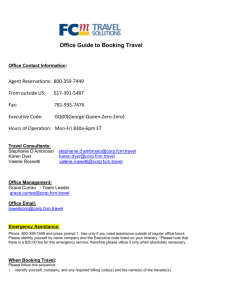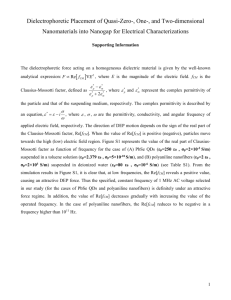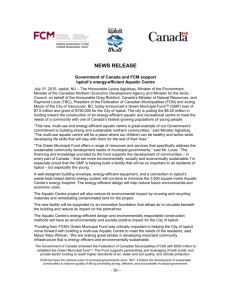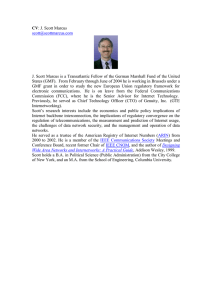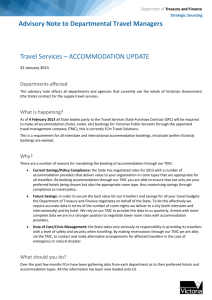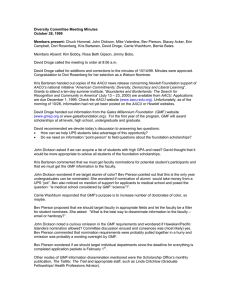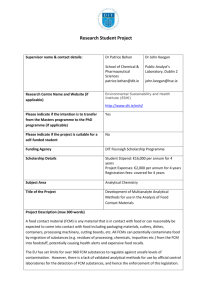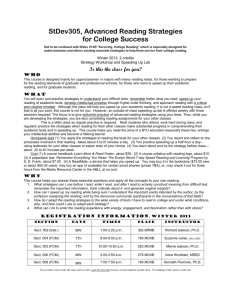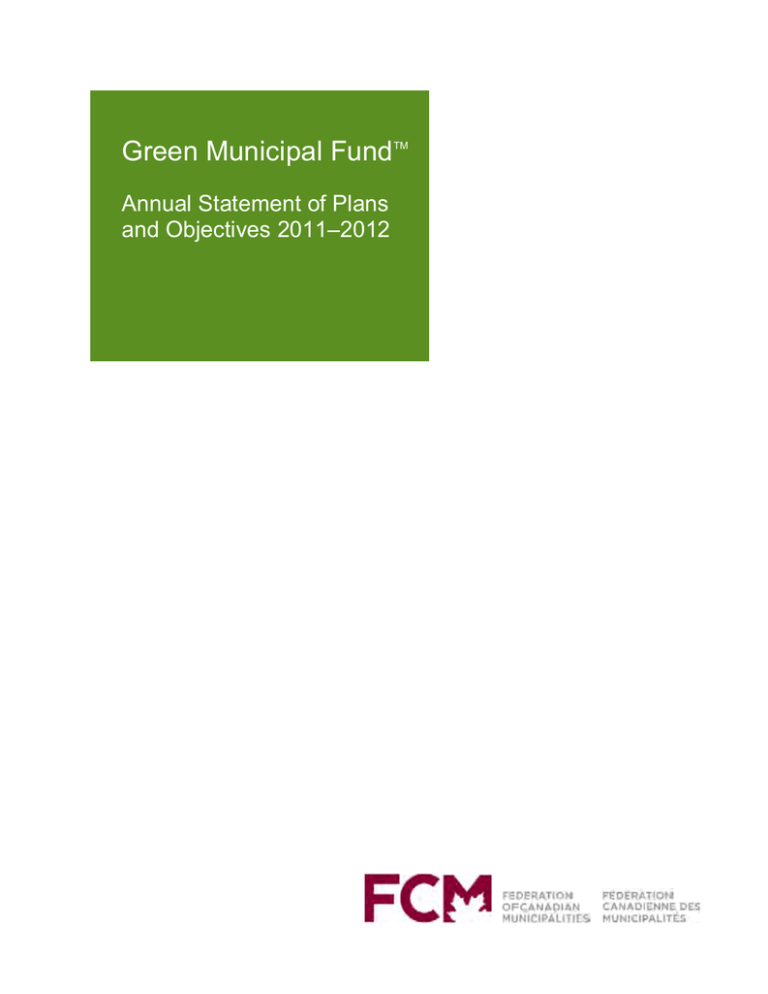
Green Municipal Fund
Annual Statement of Plans
and Objectives 2011–2012
TM
Annual Statement of Plans and Objectives 2011–2012
© 2011 Federation of Canadian Municipalities. All rights reserved.
Cette publication est aussi disponible en français sous le titre Énoncé annuel des plans et des
objectifs 2011–2012.
Federation of Canadian Municipalities
24 Clarence Street
Ottawa, Ontario K1N 5P3
www.fcm.ca/gmf
Table of Contents
Green Municipal Fund™
Annual Statement of Plans and Objectives 2011–2012
Introduction................................................................................... 1
Core functions ............................................................................. 3
Key results from 2010–2011 ......................................................... 5
Planned activities for 2011–2012 ................................................ 10
Capital and risk management ..................................................... 15
Appendix A: Compliance indicators 2011–2012.......................... 18
Appendix B: GMF budget 2011–2012......................................... 23
Appendix C: Funding Agreement articles 11.05 and 11.07 ......... 24
Appendix D: Logic model ........................................................... 25
Introduction
This year, in response to clear client
feedback, FCM increased GMF loan and
grant amounts and added flexibility to the
GMF financial offer for capital projects in
terms of disbursement and payback.
The Government of Canada endowed the
Federation of Canadian Municipalities (FCM)
with $550 million to establish the Green
Municipal Fund™ (GMF). The Fund was
designed to provide a long-term, sustainable
source of financing for municipal
governments and their partners, and to
support communities to improve air, water
and soil quality, and to protect the climate.
Eligibility is now structured on
environmental objectives or outcomes, as
opposed to specific project types, and a new
set of eligibility criteria based on
environmental objectives has been
developed. A new, single online application
form with a self-screening questionnaire was
launched in tandem with the updated
funding offer.
GMF financial products directly support
municipal initiatives, while its knowledge
products and services provide training and
other resources to help municipal
governments build their capacity.
This greater emphasis on client needs goes
hand-in-hand with FCM’s stronger
orientation towards results and continuous
improvement of all products and services.
FCM will continue its efforts to streamline
GMF’s operations and increase client
service capacity; enhance marketing,
communication and product development
activities; provide new opportunities to
leverage GMF funding and knowledge
services; and ensure that GMF remains
relevant to the changing needs of municipal
governments.
Grants are available for sustainable
community plans, feasibility studies and
field tests, while a combination of grants and
low-interest loans are available for capital
projects. GMF funds initiatives with high
potential for environmental benefit that,
where possible, also demonstrate significant
social and economic advantages. Then,
using a range of knowledge products and
related education, training and capacitybuilding services, it shares the lessons and
experience gained through these leading
examples of sustainable development to
encourage other communities to replicate
their success.
1
Scope and organization
Purpose
The purpose of the Annual Statement of
Plans and Objectives (ASPO) is threefold:
1. To fulfill the requirements outlined
in the 2005 Funding Agreement with
the Government of Canada.
Following the requirements listed in the
2005 Funding Agreement between FCM and
the Government of Canada, this document
reports on the general management of the
Fund, successes and remaining challenges,
as well as planned activities and expected
results for the 2011–2012 fiscal year.
2. To serve as a reporting tool for the
GMF Council and the FCM National
Board of Directors.
Key results from 2010–2011 are based on
the 2008–2011 strategic plan. Planned
activities for 2011–2012 reflect the 2011–
2014 strategic plan currently being
developed by the GMF Council and are
presented in eight key result areas:
3. To set priorities and targets for FCM
in administering GMF.
1. Streamlining operations
2. Determining and understanding the
needs of the GMF target audiences
3. Measuring outcomes
4. Leveraging for greater impact
5. Building capacity
6. Focused marketing
7. Integrating communications
8. Funding Brownfields
Specific tasks, processes and milestones are
captured in separate program business plans.
2
Core functions
The GMF core functions and key result areas of the GMF strategic plan are linked through the
GMF logic model (see figure 2, page 25).Under the direction of the GMF Council, FCM
integrates the logic model with a robust measurement system.
Figure 1: Core functions
SERVICES and RESOURCES
PRODUCTS and
SERVICES
APPLICATIONS
CLIENT
MARKET
RESEARCH
FUNDING
PERFORMANCE
REPORTING
RISK and INVESTMENT MANAGEMENT
3
Market research
Committee, whose evaluations are reviewed
and recommended by the GMF Council and
approved by the FCM Board of Directors.
Market research and analysis helps FCM
understand the demand for GMF products
and services and the role of similar products
and services offered by other organizations.
Understanding the needs of municipal
governments and potential clients allows
FCM to design relevant funding products as
well as knowledge products and services.
Funding
Once an application has been approved,
FCM prepares, negotiates and administers
the grant or loan agreements with successful
applicants.
Products and services
Performance reporting
FCM designs and develops funding products
based on client needs. These products are
continuously tested, assessed and adjusted to
maximize their value.
Each GMF-funded initiative must report on
results. FCM analyzes these results — the
environmental, social and economic benefits
achieved — to report on the impact of the
Fund, including funding committed,
leveraged and disbursed.
Knowledge products and services, including
education, training and capacity-building
services, are designed and developed to
support GMF’s role as an agent of change
and provider of sustainable solutions at the
municipal level. They help municipal
governments and their partners undertake
the kinds of initiatives funded by GMF or to
replicate initiatives already funded by GMF.
Risk and investment
management
Engaging clients through education, training
and capacity building also offers
opportunities for continuous feedback on the
suitability and value of all GMF products
and services.
FCM oversees the credit risk structure of the
loan portfolio to balance risk with demand
for funding, and to preserve the long-term
sustainability of the Fund. An external
manager manages investment of the nondisbursed funds under the guidance of the
investment policy and strategy as set out in
the GMF Funding Agreement.
Applications
Corporate resources
A number of integrating services and
resources support core functions. These
include strategic planning, budgeting,
administration, human resources, business
and information systems, and
communications and marketing. Other
corporate services include ensuring
compliance with the GMF Funding
Agreement and other obligations and
supporting governance functions.
FCM actively solicits applications from
target markets such as economic
development organizations, developers,
architects, real estate agents, urban planners,
and municipalities to help meet funding
priorities.
FCM also provides technical assistance to
municipalities that wish to pursue
applications. Eligible applications are
assessed by the GMF Peer Review
4
Key results from 2010–2011
environmental benefit and go beyond
business as usual, but are still achievable.
The 2008–2011 strategic plan developed by
the GMF Council grouped activities into six
key result areas to gauge incremental
progress over the coming years.1 Activities
undertaken in 2010–2011 aimed to achieve
measurable progress in each key result area.
A brief discussion of important successes in
2010–2011, as well as remaining
challenges, follows.
Understanding the needs of municipal
governments with respect to financing
brownfield initiatives also remains a top
priority for FCM. The GMF Funding
Agreement requires FCM to make its best
effort to commit $150 million in loans to
brownfield projects by March 2012, and one
third of the Fund thereafter.
Understanding the needs of the
GMF target audiences
Measuring success
In direct response to feedback received from
municipal governments, FCM significantly
updated the GMF funding offer for capital
projects to better meet client needs.
Although FCM has supported almost 870
initiatives across Canada and committed
$500 million in grants and low-interest loans,
challenges remain in measuring the impacts
of the Fund. To address this challenge, FCM
has developed a robust measurement
framework system for capital projects based
on the lessons it has learned after 10 years of
managing GMF.
FCM has increased GMF loan and grant
amounts, added flexibility in terms of
disbursement and payback, and eliminated
penalties so that clients have more
confidence about what they can expect to
receive once they have been approved for
funding.
The new performance measurement system
assesses the environmental, economic and
social benefits and associated key
improvements to quality of life resulting
from GMF-funded initiatives. The system
also evaluates a project’s degree of
innovation, replicability and
comprehensiveness.
In addition, eligibility is now structured on
environmental objectives or outcomes as
opposed to specific project types. By not
specifying the project type, municipalities
are now able to plan and seek GMF funding
on a range of projects that may all be very
different but lead to the same environmental
outcomes. To guide this process, a new set
of eligibility criteria based on environmental
objectives has been developed for capital
project funding. FCM aimed to establish
criteria that result in significant
After pilot-testing the new system, FCM has
now integrated the framework into its
management and reporting processes and
calculated results for all capital projects
completed to date. This allows FCM to
report on the actual environmental benefits
of funded projects, rather than just the
anticipated benefits.
1
Two new key result areas targeting communications
and brownfields have since been added to the
strategic plan. They are addressed in “Planned
Activities for 2011–2012.”
5
A new Environmental Results Report
system is also under development, which
will allow funding recipients to report the
environmental impacts of their funded
projects.
such as help text and sample responses to
assist applicants in completing the form.
Early feedback from applicants has been
positive, indicating that questions and
requirements are clear and that the form is
easier to complete. Technical issues are
being resolved as they are identified, and the
form will be continuously improved on a
regular basis in response to client feedback.
FCM continues to make improvements
based on the recommendations and
observations of the 2009 KPMG review and
performance audits of GMF. Both reports
are available on the GMF website (click on
About us and Annual Reports on the left
navigation menu).
Leveraging for greater impact
FCM continues its efforts to ensure that the
Fund’s offerings are well-positioned and
competitive; to stay informed regarding
other funding opportunities available for
municipalities; to pilot cross-promotion with
other funders; and to investigate co-funding
and partnership opportunities.
This year, FCM introduced the framework
for an organizational GMF performance
management system using a balanced
scorecard approach. The balanced scorecard
is a strategic planning and management
system used extensively in business and
industry, government and non-profit
organizations worldwide to align business
activities to the vision and strategy of the
organization; to improve internal and
external communications; and to monitor
organization performance against strategic
goals.
GMF continues to partner with key
organizations to assist in the profiling,
marketing and delivery of its market
offerings. These partnerships include
associations, the private sector, and publicsector agencies with leading-edge expertise
in our target priorities. These strong
relationships assist GMF with greater
opportunities for capacity building and
knowledge development.
FCM will continue to implement and make
refinements to this system to provide regular
reports to the GMF Council on key GMF
performance indicators on measurable
outcomes.
Current partnerships include organizations
such as the Ontario Centre for
Environmental Technology Advancement,
the Association Québecoise de la Maitrise
de l’Énergie (AQME), Economic
Development Association of Canada,
Montréal Urban Ecology Centre, Canadian
Brownfield Network, Canada Green
Building Council, Canadian Urban Transit
Association, Canadian District Energy
Association, and many more. GMF will
continue to develop and improve
partnerships and collaboration efforts
throughout 2011.
Streamlining operations
FCM continues to improve and fine-tune the
new application, contracting and
disbursement processes implemented at the
end of last year. Improvements have also
been made to the loan and grant agreements,
and work is ongoing to update these
documents to reflect and support the updated
funding offer.
FCM launched a new GMF application form
featuring a simple and attractive PDF format,
a self-screening questionnaire, and tools
6
This year FCM also identified an
opportunity to leverage GMF and develop
new, complementary national programs.
Several of these initiatives are part of
FCM’s increased focus on climate change,
sustainability, and the green economy; and
build on the environmental results achieved
through GMF. Others, such as new
programs to increase the participation of
women in municipal politics and to
encourage partnerships between First
Nations and neighbouring municipalities,
target social and economic sustainability.
program partners and B.C. municipalities.
The series earned FCM and its partners a
2010 Brownie Award.
FCM has recently signed an agreement with
OCETA to support a second brownfields
workshop series to be held in selected
locations across the country in 2011.
The wealth of knowledge from GMFfunded initiatives and from GMF education,
training and capacity-building services
continued to grow this year. FCM has
generated approximately 150 case studies
this year alone, and has produced nine other
knowledge products that have been shared
with municipal stakeholders and used in
GMF’s education and training programs.
FCM also continues to share its
sustainability expertise at major events such
as at national and regional conferences and
workshops focused on the GMF funding
sectors.
New knowledge products to enhance
municipal sustainability in the GMF funding
sectors include the Brownfields Roadmaps
and the addition of over 60 new entries to
the Municipal Sustainable Bylaw Collection
(MSBC) launched earlier this year. The
MSBC highlights the sustainability bylaws,
policies and procedures implemented by
small and large municipalities across
Canada.
Capacity building
FCM has established a five-year plan for
GMF’s capacity-building activities, which
sets priorities for GMF’s education and
training services and products for the next
five years.
Activities undertaken this year were
designed to make stronger links between
capacity building, GMF objectives and
municipal needs. One example is the effort
to build capacity to advance brownfields
redevelopment across the country.
FCM received over 70 applications to the
2011 FCM Sustainable Community Awards,
with seven of the 12 winning initiatives
funded by GMF. This year’s Awards saw
multiple winners in the energy, planning and
waste categories, and also introduced a new
integrated neighbourhood development
category.
FCM, in partnership with the Government of
British Columbia, the Ontario Centre for
Environmental Technology Advancement
(OCETA) and the Canadian Petroleum
Products Institute, delivered a workshop
series entitled Building B.C. Local
Government Capacity for Brownfield
Redevelopment. This series of four one-day
workshops brought together experts in
brownfield technologies, legislation, funding
and capacity building; introduced a new
provincial Brownfields Roadmap tool; and
strengthened relationships between the
The 2011 FCM Sustainable Communities
Conference was hosted by the City of
Victoria and the Capital Regional District,
marking the first time it has been held
outside of Ottawa. This year’s theme —
Embracing Change for Sustainability:
Innovative governance, partnerships and
financing — offered rich content and
7
through PCP’s GHG Reduction Initiatives of
the Month series. Four PCP webinars
focusing on climate change were held, along
with five PCP workshops and seminars at
the 2011 Sustainable Communities
Conference.
excellent networking opportunities with
municipal leaders in sustainability.
Summaries and presentations from the 2011
conference will soon be available online.
The FCM Sustainable Communities Mission
will bring a delegation of municipal
decision-makers on a study tour of leading
sustainable community development
projects in Quebec in August 2011.
Participation in the bilingual tour will be
open to all Canadian municipalities.
With support from Environment Canada, the
Enviro-Fleets pilot project was launched to
support municipal fleet managers in
reducing emissions from heavy-duty
vehicles. Two webinars and four full-day
workshops were delivered, reaching over
200 participants from small and large
municipalities across the country. A webbased Guide to Helpful Resources, along
with a Guide to Best Practices, was also
launched to inform and motivate municipal
fleet managers. Through surveys and other
feedback mechanisms, FCM has gathered
important information on where more
resources and tools are required to reduce
municipal fleet emissions. FCM hopes to
continue to meet these needs by extending
the Enviro-Fleets project beyond March
2011.
The GMF webinar series continues to reach
a wide municipal audience, drawing positive
feedback from participants across the
country. Webinars consistently reach
maximum registration. Participant feedback
from the fall 2010 webinars showed that 90
per cent of respondents felt the webinar had
increased their knowledge of the subject
area; 88 per cent would apply what they
learned in their own work; and 94 per cent
would recommend the GMF webinars to
others. About one quarter of webinars held
this year were delivered in French and
targeted to Quebec audiences.
Marketing and communications
This year has also seen considerable activity
in the Partners for Climate Protection
program. Eleven new municipalities have
joined the program as of December 2010,
for a total of 211 PCP members, and PCP
members have completed 53 corporate and
50 community milestones. The PCP
program is in the first year of its five-year
strategic plan to respond to the municipal
momentum on climate change.
A renewed approach to client-centric
marketing and communications was adopted
this year with the internal realignment of
GMF work groups and a new focus on
strategic and targeted marketing efforts.
FCM staff promoted GMF products and
services through a variety of in-person
communications, print and electronic
materials, advertisements, and the media.
With over 4,000 subscribers, the quarterly
GMF newsletter and regular e-mail bulletins
continue to provide timely updates, news
and publications of interest to municipalities
across Canada.
FCM and ICLEI – Local Governments for
Sustainability collected data for PCP’s third
national measures reporting project. The
results include over 182 initiatives
representing 350,000 tonnes of GHG
reductions and are tracked in a database
maintained by ICLEI. Emissions reductions
achieved by PCP members were recognized
To increase the number of applications for
funding for brownfields initiatives, FCM’s
8
regional advisors and other staff delivered a
series of promotional presentations and
conducted a series of meetings with
interested municipal governments and their
partners. It is anticipated that other activities,
such as the development of a Frenchlanguage training workshop and regular
promotion of brownfields funding through
electronic bulletins and other
communications vehicles will continue to
produce results.
FCM continues to focus on increasing the
profile of GMF in Quebec and the number
of applications from Quebec municipalities
and their partners.
9
Planned activities for 2011–2012
Key result area 1: Streamlining operations
Objective: Establish the prospect, application, contract to disbursement process so that it is
defined by an indicator, standard timeline and performance reporting, and facilitates access and
participation for both rural and urban municipalities and across regions.
Activities
Implement remaining recommendations of the 2009 KPMG audits to increase the efficiency
and effectiveness of GMF processes.
Establish an integrated customer relationship management system.
Continuously review and improve mechanisms to simplify project loan and grant agreements
in a timely manner.
Key result area 2: Determining and understanding the
needs of the GMF target audiences
Objective: Focus activities and develop products so that they are aligned with client
needs.
Activities
Analyze key trends and initiatives associated with GMF, as required.
Conduct research to stay apprised of developments in the GMF sectors.
Design, assess, review and continually improve targeted funding opportunities for capital
projects to enable municipal governments and their partners to develop and implement
sustainable projects in different regions and community types across Canada.
10
Key result area 3: Measuring outcomes
Objective: Measure and demonstrate the qualitative, quantitative, short-term and long-term
success of GMF.
Activities
Measure and report on:
appropriate environmental indicators for projects that:
o
include return on investment
o
provide both baseline and actual data at project completion
appropriate social and economic measures for projects
Implement a continuous improvement performance management system for GMF using a
balanced score card approach.
Provide a regular report to the GMF Council which includes key performance indicators on
measurable outcomes.
Key result area 4: Leveraging for greater impact
Objective: Collaborate with stakeholders (e.g. other funding agencies, NGOs, governments,
service providers, etc.) for mutual benefit and greater overall impact reflected in projects, plans
and studies approved for funding by FCM.
Activities
Develop, implement and measure a partnership and co-funding strategy and strategies to focus
on increasing uptake in certain regions and sectors.
Explore and assess innovative and complementary financing instruments with a view to
increasing GMF funding capacity.
Encourage integrated development projects that aim for replication of GMF-funded projects.
11
Key result area 5: Building capacity
Objective: Deliver knowledge, training, and networking activities that leverage GMF to
accelerate the implementation, communication and replication of sustainability initiatives in
Canadian municipalities.
Activities
Implement mechanisms to ensure knowledge and lessons learned from innovative GMFfunded projects are shared in a timely fashion.
Contribute to the design and implementation of a corporate website with integrated social
media capabilities that allows clients to better search and retrieve knowledge products, and
identify and develop new resources and tools to support a resource-rich web presence.
Initiate an electronic knowledge management system that will store, classify and track
knowledge products.
Using GMF knowledge and lessons learned, plan and deliver key events including the FCM
Sustainable Communities Mission, the FCM Sustainable Community Awards, the FCM
Sustainable Communities Conference, and workshops (including webinars).
Leverage PCP to deliver knowledge, education and training to GMF’s target audiences
(leading to GMF applications).
Key result area 6: Focused marketing
Objective: Design and implement highly targeted, customer-based messaging and sales
activities that speak to the direct needs of our priority markets.
Activities
Design and implement a key points of touch program with applicants to improve the
conversion process throughout, from prospect to application, and contract to disbursement.
Design creative external messaging that speaks to the specifically defined needs of each target
audience.
12
Key result area 7: Integrating communications
Objective: Ensure that targeted/core priority messages are infused, supported and
integrated into all GMF points of touch, both internally and externally.
Activities
Develop and maintain an integrated marketing and communications strategy aligned with the
FCM Corporate Communications Strategy.
Review and recommend a database management process/system to assist in improved
messaging to targeted groups and priority markets.
Investigate cost-effective opportunities for accessing target market databases.
Profile significant GMF-funded projects in a timely fashion to allow for improved client
awareness and potential replication.
Key result area 8: Funding brownfields
Objective: Continue to provide best efforts to achieve $150 million in funding by 2012.
Activities
Design a creative outreach campaign with a strong value proposition for the development and
economic development communities.
Establish partnerships with key stakeholders in relevant sectors.
Continue to develop the Brownfields Practice Group as a strategic think tank.
Increase GMF outreach awareness and capacity on financial deal structuring of multiple level
partners to assist in brownfield market development.
13
Capital and risk management
to complement the Fund’s risk
identification, evaluation and loan
monitoring activities.
Sound capital and risk management is
critical to ensuring the long-term
sustainability of the Fund. By employing
risk mitigation strategies for the loan
transactions and knowing the risks it is
taking, the Fund also strives to optimize
capital and use resources efficiently. The
Fund employs sound cash-flow and
investment management approaches in order
to maintain capital in line with the Funding
Agreement and to generate sufficient
interest income to finance operating costs
and grants.
Consistent with section 11.04 (h) of the
Funding Agreement, FCM has established a
risk profile of the loan portfolio to prudently
manage the risks assumed through GMF
lending activities. Six risk levels are used to
define the risk profile of the total loan
portfolio (disbursed and committed loans):
o
o
o
o
o
o
As of September 30, 2010, GMF managed
approximately $602 million and had an
externally restricted fund balance of
approximately $560 million.
low-risk (risk level A)
low- to medium-risk (risk level B)
medium-risk (risk level C)
medium- to high-risk (risk level D)
high-risk (risk level E)
unacceptable risk (risk level F)
To manage the risk of the total loan
portfolio, FCM sets annual target risk levels
and monitors these targets quarterly. The
Fund establishes concentration limits for
each risk level and borrower. These
concentration limits reflect both the Fund’s
sustainability imperative and the reality of
target market conditions particularly related
to anticipated uptake in the brownfields
sector. Since a large percentage of this
sector’s lending activity is driven by
municipal private partners that are generally
qualified at a higher risk level, it is expected
that the risk composition of the portfolio
will, as the total portfolio grows, trend
toward an increase within the medium-high
to high-risk sections of the portfolio’s risk
profile.
Cash flow management
The 10-year cash flow forecast model that
FCM uses to ensure long-term viability of
the Fund enables the achievement of a
balance between investment and loan
interest income, loan and grant
commitments, as well as disbursements and
operating expenses, while ensuring the
Fund’s sustainability. A minimum lending
yield policy has been established to provide
for a minimum return on the lending
activities of the Fund while ensuring that
capital is preserved.
Risk profile of GMF loan
portfolio
FCM applies sound policies and procedures
for credit risk management and loan pricing
14
Table 1: Risk profile of the total loan portfolio
(as of September 30, 2010)
Committed and
disbursed portfolio
Low-risk (A)
Low- to medium-risk (B)
Medium-risk ( C)
Medium- to high-risk (D)
High-risk (E)
Unacceptable risk (F)
Total
Percentage of
total portfolio
43.74%
20.01%
33.68%
2.27%
0.30%
0.00%
100%
Objectives for
2010–2011
At least 30%
At least 20%
20-45 %
Up to 5%
Up to 2%
0%
100%
Objectives for
2011–2012
At least 30%
At least 20%
Up to 35%
Up to 7.5%
Up to 7.5%
0%
100%
at a higher risk than municipal or municipal
corporation clients.
As of September 30, 2010, the total loan
portfolio is in line with the 2010–2011 target
risk levels. Objectives for the 2011–2012
period are to maintain the nominal risk
composition with slight movement towards
a higher risk level to account for municipal
private partner applications in the
brownfield sector, comparatively evaluated
The risk profile of the disbursed loan
portfolio shows the risk distribution of loans
that are disbursed and in repayment. At
September 30, 2010, 47 loans amounting to
$125.9 million have been fully disbursed.
Table 2: Risk profile of the disbursed loan portfolio
(as of September 30, 2010)
Risk
level
A
B
C
D
E
F
Total
Outstanding
Number of
loan amounts
contracts
($ million)
19
9
18
0
1
0
47
$55.1
$17.4
$52.5
$0.0
$0.9
$0.0
$125.9
Percentage
loans in risk
level to total
disbursed loans
43.76%
13.82%
41.70%
0.00%
0.71%
0.00%
100%
Most of the committed loans are approved to
municipal governments, with a portfolio risk
composition not materially different than the
current disbursed loan portfolio.
The majority of the outstanding loans are
held by municipal governments or
municipally owned corporations.
The committed loans (not disbursed) have
also been assigned a risk level.
15
Loans and grants for capital projects
FCM offers a combination of grants and
low-interest loans in support of capital
projects. Grants are only offered in
combination with loans. Under the Funding
Agreement, FCM must aim to commit $50
to $70 million per year in loans. Up to
March 31, 2009, FCM may commit $7 to
$10 million per year in grants to capital
projects, and $5 to $6 million thereafter.
FCM must also aim to commit $150 million
in GMF loans for brownfield projects by
March 31, 2012.
Investment management
FCM appointed an investment advisor to
assist with the evaluation and management
of the investment portfolio of the Fund and
advise the Investment Committee on the
performance of the investment manager.
The appointment completes the governance
framework for the Investment Committee
and is in line with the requirements of the
Funding Agreement. The new investment
advisor has proposed numerous
improvements to the cash-flow management
of the Fund aimed at increasing return on the
portfolio.
In fulfillment of these requirements, a
minimum of $150 million in low-interest
loans will be available for capital projects in
2011–2012. Of this amount, a minimum
total of $ 85 million will be available for
brownfield projects.
Funding targets for 2011–2012
The funding targets for 2011–2012 are
highlighted below.
Grants for sustainable community
plans, feasibility studies and field
tests
Under the Funding Agreement, “FCM shall
use its best efforts to commit to… granting
$8 to $12 million per year, from April 1,
2005, to March 31, 2009.” The Agreement
anticipates that by March 31, 2009, all
remaining GMEF[2] grant funds will have
been disbursed. FCM projects that all of the
$50 million GMEF funds will be disbursed
by the end of 2011–2012.
A minimum total of $5 million will be
available in grants for capital projects. This
amount has been allocated consistent with
the funding levels targeted for loans. Under
the provisions of the Funding Agreement,
brownfield projects are not eligible for grants.
After March 31, 2009, FCM must aim to
commit $6 to $8 million in grants for
sustainable community plans, feasibility
studies and field tests. In fulfillment of this
requirement, FCM will make a minimum
total of $6 million available for feasibility
studies, field tests and sustainable
community plans in 2011–2012.
2
Through the 2005 Funding Agreement, the Green
Municipal Fund™ replaced the earlier, $50 million
Green Municipal Enabling Fund (GMEF), which
provided grants for sustainable community plans,
feasibility studies and field tests, and the Green
Municipal Investment Fund (GMIF), which provided
grants and loans for capital projects.
16
Future market considerations
The 2011–2012 fiscal year is projected to be
impacted by a number of realities and
market shifts. Strategies are being developed
to address the following issues as they
emerge, and to develop the ability to shift
and modify products and services to
accurately adapt as required:
The completion of the economic
stimulus funding and the potential
increased uptake in GMF funding.
Market awareness that private-sector
and incorporated not-for-profit
development organizations are
becoming lead project managers in
the market areas of brownfields and
ICES.
Private-sector and incorporated notfor-profit development organizations
are higher risk challenges, but offer
opportunities for greater rates of
return.
Brownfield markets are emerging
and opportunities exist for an
increased volume of funding uptake.
To address potential funding
limitations and allow for ongoing
market penetration, research on
alternate funding mechanisms and
programs will be a priority.
17
Appendix A:
Compliance indicators 2011–2012
The following table outlines the requirements of the Funding Agreement and the associated
compliance indicators. FCM will report quarterly to the GMF Council on its progress against
these indicators in 2011–2012.
Funding
Agreement
reference
6.04 (f)
6.04 (g)
Funding Agreement requirement
The Board will establish a Council to
oversee and advise the Board on an
appropriate balance in the number of
approved grants and loans between
urban and rural communities within
Canada.
The Board will establish a Council to
oversee and advise the Board on an
appropriate balance in the number of
approved grants and loans among
regions within Canada.
18
Indicator
Target
2011–2012
Approved grants
and loans to urban
communities
$128,800,000
Approved grants
and loans to rural
communities
$32,200,000
Approved
grants and
loans to New
Brunswick,
Newfoundland
and Labrador,
Nova Scotia
and Prince
Edward Island
$8,690,000*
Approved
grants and
loans to
Québec
$56,810,000*
Approved
grants and
loans to
Ontario
$46,490,000*
Funding
Agreement
reference
Funding Agreement requirement
Indicator
Target
2011–2012
Approved grants
and loans to
Alberta, Manitoba,
Northwest
Territories,
Nunavut and
Saskatchewan
$33,190,000*
Approved grants
and loans to
British Columbia
and Yukon
$15,820,000*
10.01 (a)
FCM shall use its best efforts to
commit to lending $50 to $70 million
per year to capital projects.
GMF capital
project loan
amount approved
$150,000,000
10.01 (a)
FCM shall use its best efforts to
commit to having 80% to 90% of
Fund Assets in loans to capital
projects by March 31, 2016, and
thereafter.
Percentage of Fund
assets in loans to
eligible projects
Approx. 55%
10.01 (b)
FCM shall use its best efforts to
commit to granting $8 to $12 million
per year, from April 1, 2005, to March
31, 2009, at which time all the
remaining GMEF funds will have
been disbursed ($50 million) and $6 to
$8 million per year thereafter, to
feasibility studies, sustainable
community plans, assessments and
field tests.
GMF feasibility
study, field test
and sustainable
community
planning grant
amount approved
$6,000,000
Cumulative net
amount of grants
committed to
feasibility studies,
field tests and
sustainable
community plans
$66,000,000
19
Funding
Agreement
reference
Funding Agreement requirement
10.01 (b)
Indicator
Target
2011–2012
Cumulative net
amount of grants
disbursed to
feasibility studies,
field tests and
sustainable
community plans
$51,000,000
$5,000,000
10.01 (c)
FCM shall use its best efforts to
commit to granting $7 to $10 million
per year from April 1, 2005, to March
31, 2009, and $5 to $6 million per
year thereafter to capital projects.
GMF capital
project grant
amount approved
10.01 (d)
FCM shall use its best efforts to
commit to lending or guaranteeing
loans to support brownfield
remediation and development totaling
in aggregate at least $150 million by
March 31, 2012.
Amount of loans
or loan guarantees
committed to
brownfield
remediation capital
projects
$85,000,000
Cumulative net
amount of loans or
loan guarantees
committed to
brownfield
remediation capital
projects
$115,000,000
Amount of Fund
assets
$594,200,000
10.02
FCM shall maintain at all times Fund
Assets, excluding the value of the
Reserve for Guarantees and the
Reserve for Non-Performing Loans, of
at least $500 million.
20
Funding
Agreement
reference
Funding Agreement requirement
Indicator
Target
2011–2012
10.03 (c)
FCM shall use its best efforts to
ensure that at least fifteen per cent
(15%) of loans outstanding at any time
will be to borrowers other than
Municipal Governments.
Percentage of
approved loans
outstanding to
borrowers other
than municipal
governments
15%
10.03 (c)
FCM will attempt to earn on average
at least one and fifty one-hundredths
per cent (1.5%) per annum above the
Government of Canada Bond rate for
equivalent terms on loans to
borrowers other than Municipal
Governments.
Average interest
rate on approved
loans outstanding
to borrowers other
than municipal
governments
4.2%
11.02
FCM shall maintain separate accounts
for the Fund and agrees to obtain and
have carried out annually an
independent third-party audit of the
financial operation of the Fund,
including investment of the
unallocated portion of the Fund
Assets, and loans, grants and loan
guarantees to Eligible Recipients for
Eligible Projects according to a
framework and timeframe approved
by the Board which measures its
overall performance in achieving the
purpose as described in Article II.
FCM will convey the audited annual
financial statements to Canada no later
than five months after FCM’s Fiscal
Year end, along with a statement of
goals and objectives for the following
Fiscal Year.
Third-party audit
of the 2010–2011
financial operation
of the Fund,
including
investment of the
unallocated portion
of the Fund assets,
and loans, grants
and loan
guarantees to
eligible recipients
for eligible
projects
21
Report on
March 31,
2011
Funding
Agreement
reference
Target
2011–2012
Funding Agreement requirement
Indicator
11.03
FCM will make public an Annual
Report of the Fund’s activities and
performance no later than five months
after FCM’s Fiscal Year end, and will
convey it to the Minister for tabling in
Parliament. The report will be based
on information derived from a resultbased management framework
developed by FCM, on
recommendation of Council and
approved by the Board.
Publication of the
2010–2011 GMF
Annual Report and
distribution to the
Minister of
Environment and
the Minister of
Natural Resources,
for tabling at
Parliament, and
other stakeholders
August 31,
2011
11.04
FCM will provide an Annual
Statement of Plans and Objectives
annually to each of the Ministers at
least two months before the Fiscal
Year begins.
Publication of the
2012–2013 ASPO
and distribution to
the Minister of
Environment and
the Minister of
Natural Resources,
for tabling at
Parliament, and
other stakeholders
January 31,
2012
* The projections provided may be impacted by the regional balance outcomes of the
applications received during the period of oversubscription.
22
Appendix B: GMF budget 2011–2012
The following table outlines the GMF budget for the 12 months ending March 31, 2012.
Expenses
Budget 2011–2012 ($)
Management:
Personnel costs
945,738
Professional services
346,200
Travel, meetings and functions
122,100
Other operating expenses
2,867,082
Total Management
4,281,120
Total Compliance
144,475
Total Council
304,215
Total Peer Review Committee
323,788
Total Funding Services
1,251,136
Client Services:
Communications
925,202
Marketing
590,053
Product Development & Research
400,187
Client Services Operations
204,005
Total Client Services
2,119,447
Knowledge Services:
Capacity Building
585,747
Knowledge Services
852,124
Total Knowledge Services
1,437,871
Total Expenses
9,862,052
Maximum Budget Allowed
10,500,000
23
Appendix C: Funding Agreement articles
11.05 and 11.07
Extracts from the March 2005 Funding Agreement between the Federation of Canadian
Municipalities and the Government of Canada:
ARTICLE XI
COVENANTS OF FCM
11.05 Initial Review and Subsequent Five-year Reviews. FCM agrees to obtain, make public
and to forward to each Minister for tabling in Parliament, an independent review using
recognized evaluations standards on the following timelines: an initial review within six months
following March 31, 2009; and subsequent reviews every five years from the date of the first
review. Such reviews will assess:
(a) adherence to the provisions of this Agreement;
(b) effectiveness and efficiency of the Fund as described in Article II;
(c) effectiveness and efficiency of the processes for setting Fund priorities and for
selecting Eligible Projects;
(d) the general operation of the Council and the Peer Review Committee;
(e) the accuracy of reported environmental, economic and social benefits and cost
savings;
(f) effectiveness of stakeholder consultation conducted in relation to the operations of
the Fund; and,
(g) lessons learned and potential for broad application of Eligible Projects.
Canada may cause the copy of the report to be laid before each house of Parliament on any of the
first fifteen (15) days on which the House is sitting after each of the Ministers receives it.
11.07 FCM to Request a Performance Audit. FCM agrees to have carried out an independent
performance (value-for money) audit to ensure the economy, efficiency and effectiveness with
which funds have been used. The audit will follow the same timelines set out in Section 11.05.
The report shall be made public and a copy shall be sent to Canada. Canada may cause the copy
of the report to be laid before each House of Parliament on any of the first fifteen (15) days on
which the House is sitting after each of the Ministers receives it.
24
Appendix D: GMF logic model
Figure 2: GMF Logic Model
25

